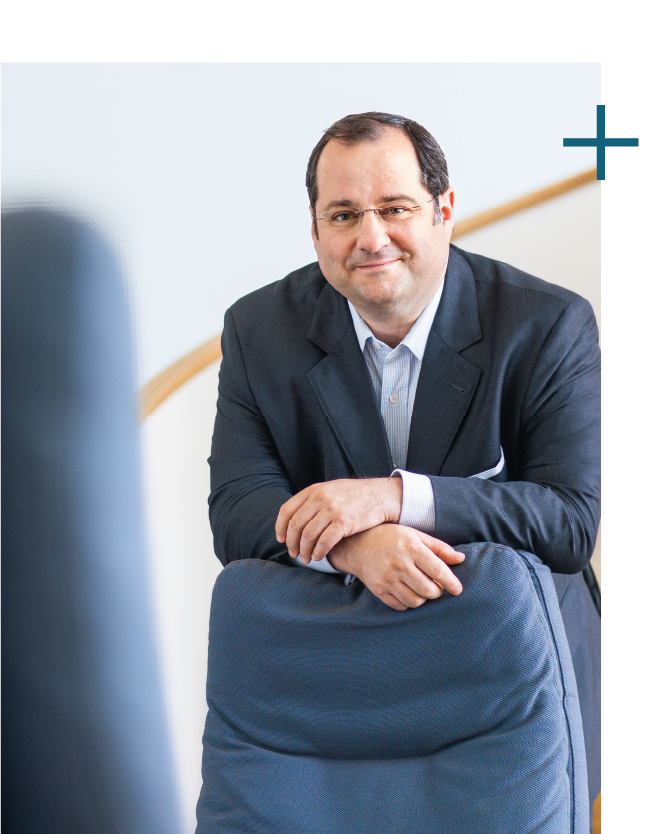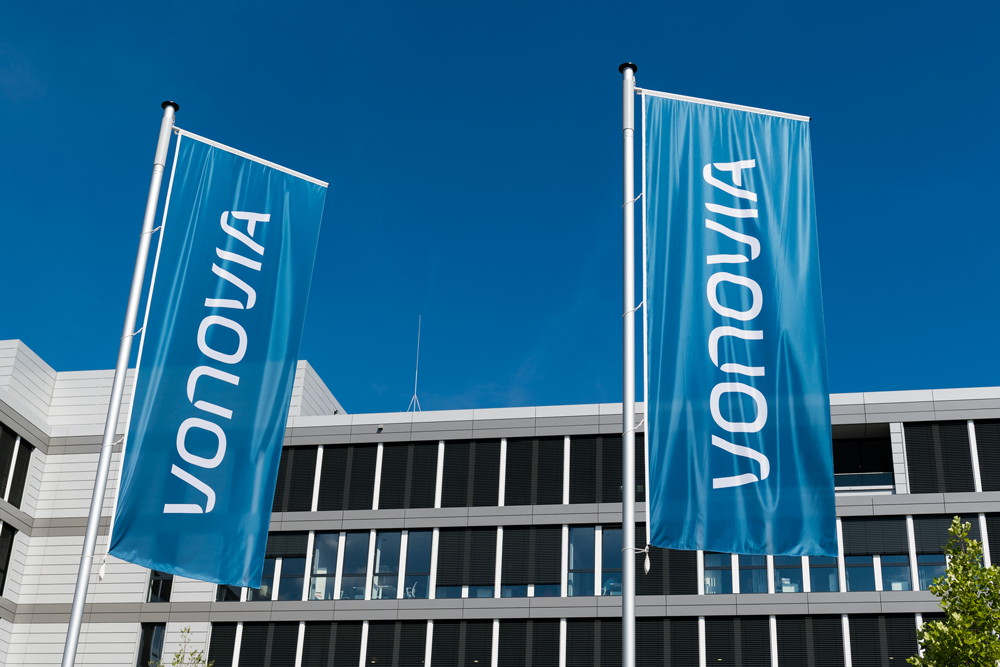Dear Shareholders,
Dear Readers,
We can look back with you on what was an extremely successful 2021 fiscal year. Thanks to a combination of our financial strength and pronounced sense of social responsibility, we improved on the relevant key figures in a year-on-year comparison. Once again, we exceeded our own forecasts.
The sustained, highly dynamic market conditions and positive performance overall is also reflected in our key figures: the net asset value, EPRA NTA, was up by 46.0% year-on-year, with the fair value rising by 66.1%. In addition to the market situation, the merger with Deutsche Wohnen as well as investments in modernization and new construction remained the main factors behind this trend. We invested a total of around € 2.19 billion in our portfolio last year. In spite of the pandemic and supply chain disruptions, we once again completed more than 2,200 apartments in Germany, Austria and Sweden – many of them based on innovative concepts. We continue to stand for affordable housing in Germany, with an average rent of € 7.19 per square meter. The vacancy rate remains at a very low level of 2.2%.
Segment revenue was up by 18.5%. Adjusted EBITDA Total and Group FFO increased by 18.8% and 24.0% respectively. These figures include Deutsche Wohnen on a pro rata basis since its consolidation in September 2021.
Our positive financial ratings remain stable. They are testimony to the trust that the capital market places in our business model and ensure smooth financing and refinancing processes. Our balanced maturity profile ensures that we only have to repay around 11% of maturities every year. Within this context, we endeavor to ensure the greatest possible diversification of our financing sources.
At 109%, the Sustainability Performance Index (SPI), as a comprehensive non-financial parameter, exceeded our forecast for the year. Our positions in renowned sustainability ratings also show that we are on the right track in this area. Last December, for example, the agency Standard & Poor’s Global ranked us among the top 7% real estate companies operating worldwide – confirming our ranking in the Dow Jones Sustainability Index (DJSI) Europe.
The customer satisfaction index (CSI) rose again by 4.5%. Our tenants know that they can rely on us in these challenging times and that we offer them security and stability.
Our successful and stable core business is a prerequisite for putting us in a position to tackle the challenges on the housing market. Demographic change, the shortage of affordable homes in sought-after towns and cities and, in particular, climate change call for our full commitment – and we know that you, our shareholders, are fully behind us as we pursue this strategy.
However, key financial figures are only secondary these days. We stand in solidarity with the people of Ukraine. Our thoughts are with the men and women who had to flee their homeland to escape from war, bring their children and grandchildren to safety and save their lives.
We can see that our society is facing the key issues of this era together – and acting together against the war. We are witnessing great readiness to help in Europe and all over the world. And we are also doing our best to help people: We will provide apartments quickly and with minimal red tape so that Ukrainians can have peace and safety, and we hope that this senseless war ends soon.
Going back to the company’s development, protecting our climate continues to be a top priority. The energy revolution is gathering pace, and social issues are playing more of a role in shaping political decisions than they have for a long time. Here at Vonovia, we are ready to help shape, and actively contribute to, these developments.
After all, in every single one of these areas, what is important now is that we do the right things. But we also have to do them in the right way. This means that we have to have our goal in mind and then plan from there, thinking about which steps are the important ones to take right now. These steps will demand a lot of us. But if we fail to show the determination we need in taking them, it will cost us all even more energy at the end of the day.
The reason I am emphasizing this so clearly is because Vonovia has a responsibility to help shape the path that will be taken. We have a clear plan that is consistent with the interests of our tenants. They need good-quality and affordable homes. The plan is consistent with your interests as our shareholders. We are developing our portfolio to make it fit for the future, allowing for returns commensurate with the risk involved. Our approach is also in the interests of climate protection, which is undoubtedly one of the key challenges of this century. Following the successful merger with Deutsche Wohnen, we will be able to address these issues with combined forces – and, as a result, with even greater strength. We will be leveraging our size to help improve the situation on the housing market again.
But another reason why I am so keen to emphasize this is because this process will require the support of all players. In addition to residential real estate companies, policymakers, tenant representatives, the construction industry and social associations are also being called upon to act. The political focus on climate protection in the construction sector is the right approach. But we must not lose sight of the costs involved for tenants and for landlords alike. Without government support, it will be impossible to create housing that is both affordable and climate-neutral.
Incidentally, this refers to the process of implementation as much as it does to the financial side of things. Vonovia has very good staff resources with around 5,000 of its own craftswomen and craftsmen. Nevertheless, we too have to explore new avenues in order to recruit more staff. I am looking forward to welcoming the first few specialists from Colombia to our company this year so that we can build on their support.
The ambitious goal of climate neutrality is forcing us to rethink a lot of things. We need to make changes: to our energy and heat supply. To our construction materials. And possibly also to our rent models. We are currently keeping a very close eye on rising energy prices. The models for rent including ancillary expenses that we are looking at are based on the idea that landlords reach an agreement with tenants on a rent that already includes the costs for heating and electricity. This benefits both sides, because landlords have an incentive to modernize their buildings to make them more energy-efficient, while society also benefits if the heating revolution in the buildings sector moves up a gear.
Germany has had a Ministry of Construction since December. New construction, serial construction, accelerated planning and approval procedures or CO₂ pricing – we are convinced that the new coalition government is pursuing the right approaches to tackling the problems. We are also receiving a boost at EU level. The Energy Performance of Buildings Directive recognizes that climate neutrality in the buildings sector must be based on a two-fold approach: energy-efficient building modernization measures and the replacement of fossil fuels with renewable energies. This validates our climate strategy, which we further developed this year by means of a new climate path. Our goal is to establish a virtually climate-neutral building stock by 2045. This goal is scientifically sound and underpinned by binding yearly targets.
We will be using other levers, too: in the future, sustainable construction materials will also help to reduce carbon emissions in both our new construction and refurbishment work. In the Berlin district of Reinickendorf, for example, we have demonstrated that construction can also be climate-friendly. Last year saw us build 60 apartments here using sustainable and modular timber construction, with a total of around 700 such apartments being built across Germany.
While this is a start, we need more. Specifically, we need more partners. This is why we will be extending invitations to a conference on the topic of construction materials – based on the model used for our own climate conference in 2020 – in November 2022. The conference will bring together experts from the housing industry, the construction and construction materials sector, associations as well as academia and politics to discuss sustainability, recycling and the affordability of construction materials. This is the only way to progress in this area, too: by facilitating dialogue among experts and a common understanding at the political, economic and scientific levels.

Rolf Buch
Chairman of the Management Board (CEO)

Philip Grosse
Member of the Management Board (CFO)

Helene von Roeder
Member of the Management Board (CTO)

Arnd Fittkau
Member of the Management Board (CRO)

Daniel Riedl
Member of the Management Board (CDO)
Dear Shareholders,
we expect to see continued positive business development in the 2022 fiscal year. As ever, we will remain on hand to support our customers as a reliable partner. We have set realistic targets as always.
As far as a climate-neutral housing stock is concerned: The amendments made to the German Climate Protection Act prompted us to revise our climate path. We now know that we can achieve our ambitious climate protection targets, which feature clearly defined interim targets, as early as 2045 instead of 2050. The number of climate projects is continuously increasing and ranges from a boom in photovoltaic technologies to new construction and innovative insulation methods and cooperation projects on the topic of green hydrogen.
We want to accelerate our neighborhood development projects even further. In 2021, we completed 15 such projects across Germany. We will be pushing ahead with these projects in 2022. We are convinced that we can only rise to social challenges, and the challenges that climate protection entails, if we consider both aspects together. To give an example: If we turn the energy revolution into a reality in our neighborhoods with the help of sector coupling, we will have sufficient green direct electricity available. If we can achieve this, then we can do away with the system of variable costs for our tenants, and just like that, we end up with a rent model in which the expenses for energy consumption form part of the fixed costs.
2022 will be dominated by the integration of Deutsche Wohnen; we are aiming to have completed the merger by the close of the year. From experience, I can say that we will soon unite around common goals when it comes to corporate culture as well. I would like to take this opportunity to warmly welcome all the company’s employees to the Vonovia team. I look forward to the collaboration, new ideas and future goals that we will set and achieve together.
As was the case last year, we will once again meet at a virtual Annual General Meeting in April. On April 29, 2022, together with the Supervisory Board, we will be proposing a dividend of € 1.66 per share. By increasing the dividend by 8 cents – taking into account the capital increase with subscription rights in 2021 – we can maintain the continuity of the last few years. As you can see, you can rely on us and Vonovia’s economic growth, even if the our share price performance does not currently reflect this strength. Macroeconomic factors are clearly having an impact here.
Our Management Board team was expanded effective from January 1, 2022, and I would like to take the opportunity to once again extend a warm welcome to Philip Grosse as CFO. Going forward, Helene von Roeder will be responsible for issues of the future related to digitalization and innovation in the housing industry in a newly created executive division.
Together with my team on the Management Board, I would like to thank you, our shareholders, partners and employees, for your trust and support over the past year. I would like to thank the Supervisory Board for what was, once again, a very positive working relationship.
This year, I am once again counting on you, our shareholders. We will only be able to achieve our shared objectives if we tackle them together. Everyone needs to do their bit if we want to continue to make a responsible contribution for our customers and society at large.
Bochum, March 2022
Sincerely,
Rolf Buch
Chairman of the Management Board



